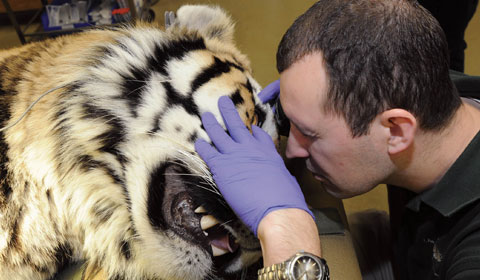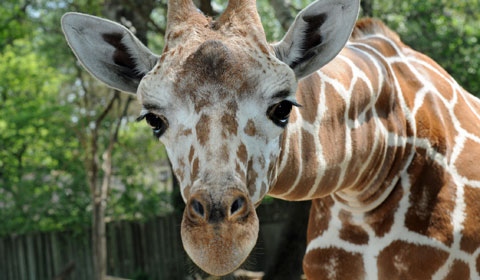News Release
Contact: Sondra Katzen, Public Relations, 708.688.8351,
sondra.katzen@czs.org
April 24, 2019
FOR IMMEDIATE RELEASE
Polar Bear at Brookfield Zoo Undergoes Physical Exam
Significant Accomplishments Attained with CT Images and Assisted Reproductive Technique
DSC_7349 and DSC_7154: Chicago Zoological Society veterinary staff position Hudson, Brookfield Zoo’s 12-year-old male polar bear, in preparation for a CT scan. The zoo acquired a new table that interfaces with its CT scanner and can accommodates animals up to 2,200 pounds, including Hudson, who weighs just over 1,000 pounds.
DSC_7488: Dr. Marina Ivančić, veterinary radiologist for the Chicago Zoological Society, takes an ultrasound of Hudson, Brookfield Zoo’s 12-year-old male polar bear, during a physical examination.
Brookfield, Ill. – This week Chicago Zoological Society’s (CZS) veterinary and animal care staff were able to accomplish significant objectives during a routine medical check-up on Hudson, Brookfield Zoo’s 12-year-old male polar bear. The team was able to acquire images of the massive animal on its CT scanner and collect semen that is being used for assisted reproductive techniques with two female polar bears.
All the animals at Brookfield Zoo receive preventative care examinations on a routine schedule to ensure their health. These exams often include CT scans and other diagnostic medical imaging to assess internal organs and other structures. Until recently, animals weighing up 660 pounds or less were able to fit on the CT scan’s table, but an animal like Hudson, who weighs over 1,000 pounds, was simply too heavy. But, that all changed at the end of last year when the zoo was able to purchase a new table with grant funding from the Aurelio M. Caccomo Family Foundation and the Judith and Alan Fleisch Endowment Fund. This new table can accommodate animals up to about 2,200 pounds and interfaces with the zoo’s existing CT scanner, which was donated in 2016 by AMITA Health.
“Being able to get baseline CT images on a polar bear is a significant accomplishment to advance the medical well-being for the species under managed care,” said Dr. Michael Adkesson, vice president of clinical medicine for CZS, which manages Brookfield Zoo. “It allows us to assess Hudson’s joints, internal organs, and overall health. The images provide us with a reference to monitor his health over time and can also be used to compare to other polar bears in the future if needed.”
The team providing care for Hudson yesterday also included a reproductive physiologist from Cincinnati Zoo’s Linder Center for Conservation and Research of Endangered Wildlife who collected semen from Hudson. Assisted reproductive techniques are still being developed in polar bears, but hold great promise for the overall population of this species in zoos. Polar bears breed seasonally and only produce one to two cubs per year, so there is a lot of interest in developing assisted reproductive techniques to aid the rate of successful breeding. The process of transporting semen is a lot easier than transferring bears between facilities and can also increase the chances of a female becoming pregnant. “The development of assisted reproductive techniques have aided the recovery of many endangered species,” said Dr. Adkesson. “These techniques have worked well in developing sustainable populations of other endangered bears like the giant panda; we hope to someday see similar success with polar bears.”
After confirming the viability of the collected sample, Cincinnati Zoo staff transported the semen to Henry Vilas Zoo in Madison, Wisconsin, to use with one of their polar bears. This week CZS veterinary staff also inseminated Nan, Brookfield Zoo’s female polar bear. The remaining collected semen will be frozen for use in the future.
With the future of the wild polar bear population being more and more threatened by climate change and the loss of arctic sea ice, it is crucial to do everything possible to ensure the survival of the species so that future generations are able to experience seeing these iconic North American mammals. Polar bears are currently listed as a vulnerable species on the US Endangered Species Act and conservation actions are considered necessary for their survival, according to the International Union for Conservation of Nature (IUCN).
# # #
About the Chicago Zoological Society
The mission of the Chicago Zoological Society is to inspire conservation leadership by engaging people and communities with wildlife and nature. The Chicago Zoological Society is a private nonprofit organization that operates Brookfield Zoo on land owned by the Forest Preserves of Cook County. The Society is known throughout the world for its international role in animal population management and wildlife conservation. Its Center for the Science of Animal Care and Welfare is at the forefront of animal care that strives to discover and implement innovative approaches to zoo animal management. Brookfield Zoo is the first zoo in the world to be awarded the Humane Certified™ certification mark for the care and welfare of its animals, meeting American Humane Association’s rigorous certification standards. Open every day of the year, the zoo is located at 8400 31st Street in Brookfield, Illinois, between the Stevenson (I-55) and Eisenhower (I-290) expressways and also is accessible via the Tri-State Tollway (I-294), Metra commuter line, CTA and PACE bus service. For further information, visit
CZS.org.
MEDIA CONTACT:
Sondra Katzen
Media Relations Manager
Office: 708-688-8351
Cell Phone: 708-903-2071
E-mail: Sondra.Katzen@CZS.org

Read about our innovative practices in animal welfare to ensure the ultimate care of our individual animals.

Create extraordinary connections with animals and nature!

Become our partner in caring for animals and in connecting people with wildlife and nature.